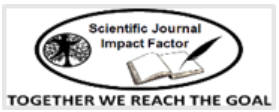Relationship between Topographic Wetness Index and Soil Physical Properties in Cikapundung Sub-watershed Using Geographic Information Systems
DOI:
https://doi.org/10.55677/ijlsar/V04I01Y2025-07Keywords:
Empirical Bayesian Kriging, Environmental Monitoring, Geostatistics, Landscape Analysis, Soil ConservationAbstract
Purpose: This study aimed to analyze the relationship between Topographic Wetness Index (TWI) and soil physical properties (permeability, porosity, bulk density, and soil moisture content) and their spatial distribution in the Cikapundung Sub-watershed.
Methods: A survey method was conducted through descriptive, correlation, and interpolation approaches. Thirty soil samples were collected based on a two-way stratification method using TWI and slope gradient. TWI was derived from Digital Elevation Model (DEM) data using GIS. Soil physical properties were analyzed in laboratory and their spatial distribution was mapped using interpolation techniques.
Results: TWI showed varying degrees of correlation with soil physical properties: significant positive correlation with soil permeability (r = 0.37), weak negative correlation with soil moisture content (r = -0.30), and very weak correlations with bulk density and soil porosity (r = -0.03 and r = 0.03). Spatial analysis revealed heterogeneous distribution patterns of soil physical properties across the sub-watershed.
Conclusion: TWI can only be effectively used as a single predictor for soil permeability, but not for bulk density, porosity, and soil moisture content in the Cikapundung Sub-watershed. This suggests the need for additional environmental parameters when predicting these soil physical properties.
References
1. Ågren AM, Lidberg W, Strömgren M, Ogilvie J, Arp PA. Evaluating digital terrain indices for soil wetness mapping – a Swedish case study. Hydrol Earth Syst Sci. 2014;18(9):3623-3634.
2. Buchanan BP, Fleming M, Schneider RL, et al. Evaluating topographic wetness indices across Central New York agricultural landscapes. Hydrol Earth Syst Sci. 2013;10:14041-13.
3. Chen X, Yang JY, Liang A, Zhang X. Effects of soil compaction and tillage practices on carbon dioxide efflux in Northeast China: Evidence from an incubation study. Pol J Environ Stud. 2016;25(4):1769-1776.
4. Cheng RR, Chen Q, Zhang J, et al. Soil moisture variations in response to precipitation in different vegetation types: A multi‐year study in the Loess Hilly Region in China. Ecohydrology. 2020;13(3):e2196.
5. Carvalho ICB, Brito AS, Matos KO, Jesus MC. Actual and relative soil air permeability as soil physical quality index. J Agric Sci. 2019;11(14):1.
6. Boggs JL, Sun G. Urbanization alters watershed hydrology in the Piedmont of North Carolina. Ecohydrology. 2011;4(2):256-264.
7. Bilgili AV, Akbas F, van Es HM. Combined use of hyperspectral VNIR reflectance spectroscopy and kriging to predict soil variables spatially. Precis Agric. 2011;12(3):395-420.
8. Ajami H, Sharma A. Disaggregating soil moisture to finer spatial resolutions: A comparison of alternatives. Water Resour Res. 2018;54(11):9456-9483.
Downloads
Published
How to Cite
Issue
Section
License
Copyright (c) 2025 International Journal of Life Science and Agriculture Research

This work is licensed under a Creative Commons Attribution 4.0 International License.













